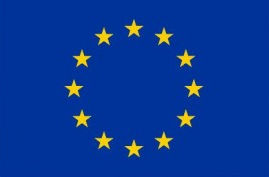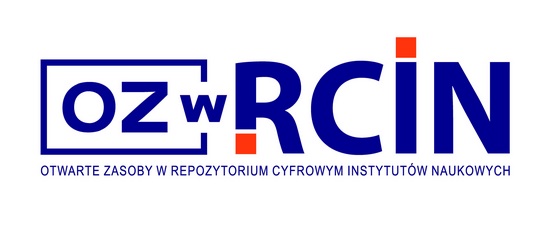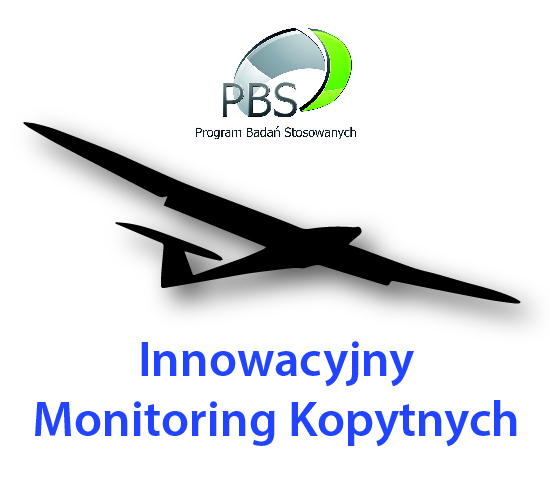Fauna Polski - Nowa seria - vol. 2 - Middle and late Pleistocene
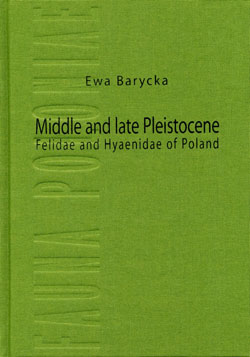 |
Ewa Barycka Middle and late Pleistocene Felidae and Hyaenidae of Poland Fauna Poloniae Vol.2 New series Museum and Institute of Zoology of the Polish Academy of Sciences and Natura optima dux Foundation. Warszawa 2008 ca 173 x 243 mm, 228 pages, 101 figures, 59 tables, hardcover ISBN 978-83-918040-5-6 |
Cena: 54 zł + koszt przesyłki
Orders:
Please contact our orders department , or use online form (secure HTTPS connection)
A revision of middle and late Pleistocene feliform carnivoran remains from the caves in the vicinity of Cracow proved the presence of Crocuta crocuta spelaea, Felis silvestris and Panthera spelaea spelaea and, for the first time, Panthera spelaea fossilis, thus enriching the list of big cats in Polish middle Pleistocene fauna. No Lynx remains were found. Analyses of Crocuta crocuta’s teeth brought about the revision of cave hyaena stratigraphy. Correlations between migration events and the size and shape of teeth were recognized. Different limb proportions are regarded as leading to a reduction of cursoriality but an increase in endurance and stability while carrying large pieces of carcass. Detailed evolutionary changes were determined in cave lion evolution. Additional diagnostic differences were recognized for Panthera spelaea. Mass and sexual dimorphism of cave lion were estimated. A marked narrowing of the lower incisors region and different proportion of limb bones were found. When compared to modern European wildcats, wildcat remains reveal intermediate characteristics between Felis silvestris silvestris and Felis silvestris tatressia.
Key words: Carnivora, Panthera spelaea, Crocuta spelaea, systematics, morphology, Europe
Fauna Polski - Nowa seria - vol.1 - Trombidiidae of Poland
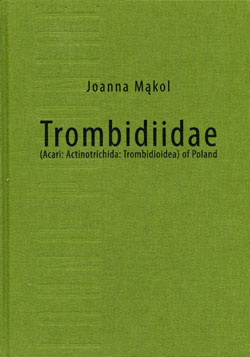 |
Joanna Mąkol Trombidiidae(Acari: Actinotrichida: Trombidioidea) of PolandFA U N A Museum and Institute of Zoology 39 tables with morphometric data, hardcover ISBN 83-918040-1-1 |
Cena: 48 zł + koszt przesyłki
Orders:
Please contact our orders department , or use online form (secure HTTPS connection)
Abstract: Twenty seven species of Trombidiidae have been recorded from Poland. Nine of them are known from larvae and postlarval instars, fourteen – exclusively from postlarval forms, four – only from larvae. Descriptions are provided with figures, distribution maps and tabulated metric characters. The following new synonyms are proposed: Sericothrombium brevimanum Berlese, 1910 (= Trombidium rowmundi Haitlinger, 1996), Acarus holosericeus L. (= Trombidium poriceps Oudemans, 1904), Trombidium rimosum C. L. Koch, 1837 (= Trombidium meyeri Krausse, 1916), Trombidium megalochirum Berlese, 1910 (= Dinothrombium rubropurpureum Oudemans, 1914), Trombidium filipes C. L. Koch, 1837 (= Podothrombium magnum Berlese, 1910, = Podothrombium proti Haitlinger, 1994, = Podothrombium roari Haitlinger, 2000), Podothrombium kordulae Haitlinger, 1995 (= Podothrombium rigobertae Haitlinger, 1995), Podothrombium verae Haitlinger, 1995 (= Podothrombium tersonderi Haitlinger, 1995). Neotypes are designated for Trombidium rimosum C. L. Koch, 1837, Trombidium fuliginosum Hermann, 1804, Trombidium molliculum C. L. Koch, 1837 and Trombidium bicolor Hermann, 1804, whereas lectotypes – for Allothrombium wolmari Haitlinger, 2000, Podothrombium macrocarpum Berlese, 1910 and Podothrombium strandi Berlese, 1910. Sericothrombium carpaticum Feider, 1950, Trombidium fuornum Schweizer, 1951 and Trombidium susteri Feider, 1956 are treated as doubtful taxa. The specific status of Allothrombium lechi Haitlinger, 1996 (syn. of Trombidium fuliginosum Hermann, 1804 [?]) and Podothrombium dariae Haitlinger, 1995 is also regarded as doubtful because of insufficiently indicated differentiating characters and the poor condition of type specimens, which do not allow a critical reappraisal of the types.
Trombidium latum C. L. Koch, 1837, Trombidium monticola sp. nov., Podothrombium macrocarpum Berlese, 1910, Podothrombium spinosum Feider, 1955 and Podo thrombium strandi Berlese, 1910 are new to the Polish fauna. Allothrombium meridio nale Berlese, 1910 and Allothrombium pergrande Berlese, 1903 should be excluded from the checklist of trombidiids of Poland due to misidentifications confirmed after studies of the type material in the Berlese Acaroteca.
Key words: Acari, Trombidiidae, taxonomy, new species, new synonyms, Poland.
Fauna Polski (Fauna Poloniae)
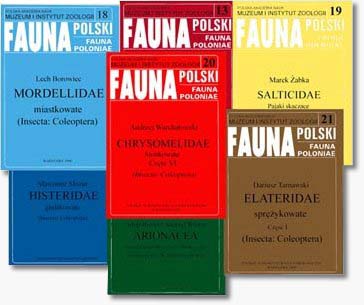
The Fauna Polski series provides synthetic review of particular animal families occurring in Poland. Each volume represents, at the time of its publication, the state of art in our knowledge concerning morphology, zoogeography, and bionomy of animals studied. It also contains detailed information about collecting methods, identification keys (in some cases also in English), systematic index, and is rich in illustrations of diagnostic characters, and relevant bibliography.
| Tom | Autorzy | Tytuł, rok wydania, strony |
Cena |
| 1 |
J. D. Plisko |
Lumbricidae - Dżdżownice (Annelida: Oligochaeta), 1973, 156 pp. |
€ 8 |
| 2 |
A. Riedel and A. Wiktor |
Arionacea - Ślimaki krążkowate i ślinikowate (Gastropoda: Stylommatophora), 1974, 140 pp. |
€ 20 |
| 3 |
S. M. Klimaszewski |
Psyllodea - Koliszki (Insecta: Homoptera), 1975, 295 pp. |
€ 15 |
| 4 |
M. Mroczkowski |
Dermestidae - Skórnikowate (Insecta: Coleoptera), 1975, 163 pp. |
out of print |
| 5 |
W. Staręga |
Opiliones - Kosarze (Arachnoidea), 1976, 197 pp. |
out of print |
| 6 |
W. Bazyluk |
Blattodea et Mantodea - Karaczany i modliszki (Insecta), 1977, 173 pp. |
out of print |
| 7 |
R. Bańkowska |
Conopidae - Wyślepki (Insecta: Diptera), , 1979, 134 pp. |
|
| 8 |
P. Trojan |
Tabanidae - Ślepaki (Insecta: Diptera), 1979, 309 pp. |
out of print |
| 9 |
S. Mazur |
Histeridae - Gnilikowate (Insecta: Coleoptera), 1981, 207 pp. |
€ 20 |
| 10 |
A. Warchałowski |
Chrysomelidae - Stonkowate (Insecta: Coleoptera). Part I, 1985, 273 pp. |
out of print |
| 11 |
L. Borowiec |
Bruchidae - Strąkowce (Insecta: Coleoptera), 1988, 226 pp. |
|
| 12 |
A. Wiktor |
Limacoidea et Zonitoidea nuda - Ślimaki pomrowiokształtne (Gastropoda: Stylommatophora), 1989, 207 pp. |
€ 15 |
| 13 |
A. Warchałowski |
Chrysomelidae - Stonkowate (Insecta: Coleoptera). Part II, 1991, 347 pp. |
€ 37 |
| 14 |
S. Niesiołowski |
Empididae aquatica - Wodne wujkowate (Insecta: Diptera). 1992, 128 pp. |
€ 10 |
| 15 |
A. Warchałowski |
Chrysomelidae - Stonkowate (Insecta: Coleoptera). Part III, 1993, 279 pp. |
|
| 16 |
A. Warchałowski |
Chrysomelidae - Stonkowate (Insecta: Coleoptera). Part IV, 1994, 302 pp. |
|
| 17 |
A. Warchałowski |
Chrysomelidae - Stonkowate (Insecta: Coleoptera). Part V, 1995, 360 pp. |
|
| 18 |
L. Borowiec |
Mordellidae - Miastkowate (Insecta: Coleoptera). 1996, 191 pp. |
|
| 19 |
M. Żabka |
Salticidae - Pająki skaczące (Arachnida: Aranea). 1997, 188 pp. |
out of print |
| 20 |
A. Warchałowski |
Chrysomelidae - Stonkowate (Insecta: Coleoptera). Part VI, 1998, 292 pp. |
|
| 21 |
D. Tarnawski |
Elateridae - Sprężykowate (Insecta: Coleoptera). Part I, 2000, 415 pp. Incl. 691 figs., keys in both English and Polish, 30 pp. of cited literature. Hard cover. |
€ 35 |
| 22 |
A. Warchałowski |
Chrysomelidae - Stonkowate (Insecta: Coleoptera). Part VII, 2000, 359 pp. Incl. supplement to parts I-VI, 345 figs., 144 pp. of cited literature. Hard cover. |
€ 37 |
| 23 |
Agnieszka Draber-Mońko |
Calliphoridae - Plujki (Insecta: Diptera). 2004, 658 pp. Hard cover. |
€ 40
|
Coleoptera Poloniae: Tenebrionoidea (Tetratomidae, Melandryidae, Ripiphoridae, Prostomidae, Oedemeridae, Mycteridae, Pythidae, Aderidae, Scraptiidae)
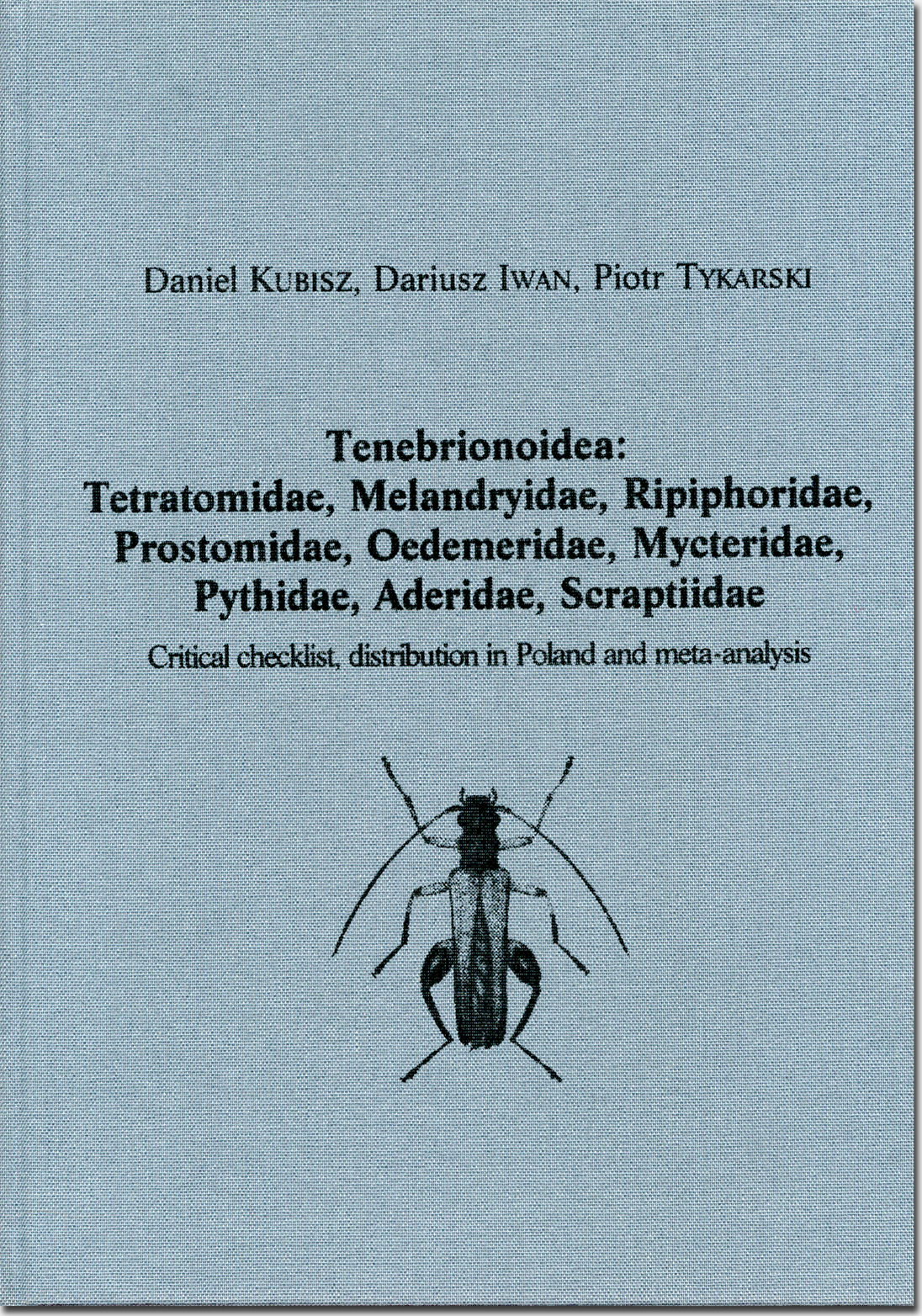 |
Critical checklist, distribution in Poland and meta-analysis Kubisz D., Iwan D., Tykarski P. 2014. Coleoptera Poloniae: Tenebrionoidea (Tetratomidae, Melandryidae, Ripiphoridae, Prostomidae, Oedemeridae, Mycteridae, Pythidae, Aderidae, Scraptiidae). University of Warsaw – Faculty of Biology, Hardcover, 176 x 250 mm, 470 pages, 209 figures, maps ISBN 978-83-935107-9-5 Price: 75 euro + 5% VAT + postage orders: Please contact This email address is being protected from spambots. You need JavaScript enabled to view it. |
Abstract
The book catalogues distribution data on occurrence of families of Tenebrionoidea. Having reviewed available distribution data, we consider 84 species to be present in Poland: Aderidae (7 species), Melandryidae (27), Oedemeridae (22), Prostomidae (1), Pythidae (3), Ripiphoridae (3), Scraptiidae (15) and Tetratomidae (6). 27 species were considered doubtful due to misindentifications or a long-term lack of new occurrences, including Mycteridae. Data on distribution of the confirmed taxa cover source references, localities, UTM 10×10 km grid coordinates, dates and collections that hold specimen, accompanied by distribution maps generalized to the UTM grid. A separate chapter gives an overview of Palaearctic distribution of all the discussed taxa, including subspecies when applicable. Detailed taxonomic checklist of the covered groups including synonymy is also provided. The distribution catalogue part is followed by the meta-analysis built upon a database covering all the presented information. A number of analytical and generalization techniques was used, giving synthetic views on research intensity and some other parameters at a species and family level. The publication follows the former volume of the Coleoptera Poloniae series, extending traditional faunistics by links to the database that is available online through the Biodiversity Map and Coleoptera Poloniae websites, served by the Polish Biodiversity Information Network (KSIB).
Key words
Coleoptera, Tenebrionoidea, Tetratomidae, Melandryidae, Ripiphoridae, Prostomidae, Oedemeridae, Mycteridae, Pythidae, Aderidae, Scraptiidae, biodiversity, faunistics, zoogeography, distribution, meta-analysis, checklist, museum collections, Poland.
